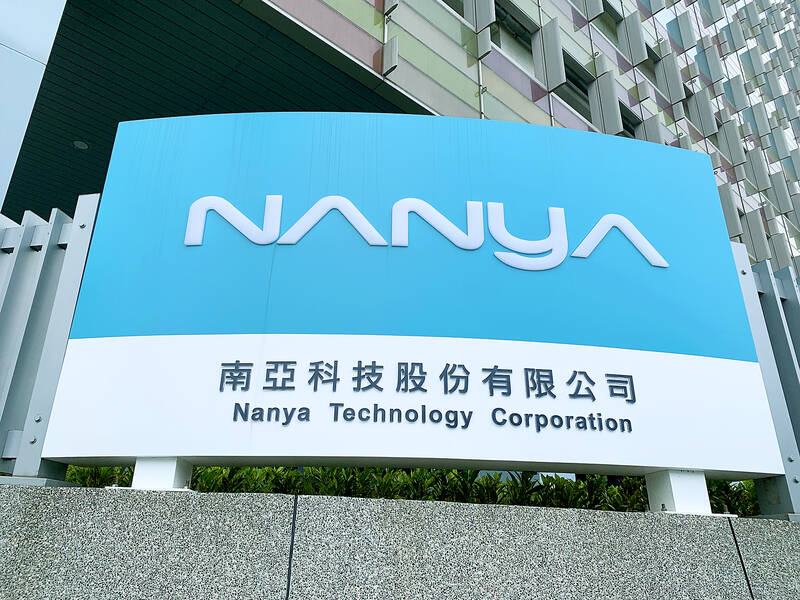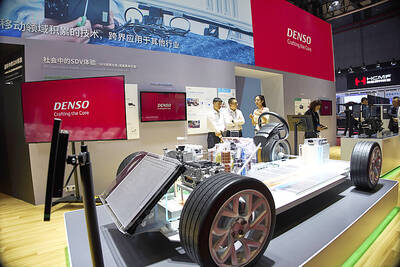DRAM chipmaker Nanya Technology Corp (南亞科技) yesterday said chip prices are expected to bottom out this quarter as supply chain inventory is diminishing at chip customers, paving the way for a gradual revival of DRAM demand in the second half of this year.
The improvement is most evident in the quarterly easing of an inventory glut in the mobile DRAM segment, which is aided by chip production cuts and a mild pickup in mobile phone demand due to China’s economic reopening, the memorychip maker told a media briefing in Taipei.
A recovery in China’s domestic demand and consumption is a key factor behind improved mobile phone sales, Nanya Technology president Lee Pei-ing (李培瑛) said.

Photo: Grace Hung, Taipei Times
However, the recovery would not happen overnight, but should come “step by step,” he said.
“As memorychip suppliers are adjusting capital expenditures and manufacturing capacity to cope with excessive inventory, we are seeing a mild improvement in [inventory] lately and expect significant [progress] in the second half,” Lee said.
In the first half of this year, DRAM demand remained dampened by surging inflation in the US and Europe, as well as Russia’s invasion of Ukraine, Lee said.
The technology dispute between the US and China also affects demand, he said.
For the whole of this year, global DRAM demand is expected to be lower than the average expansion of 10 to 20 percent annually in the past few years, but Nanya Technology is confident about the industry’s long-term growth outlook, Lee said.
To cope with the short-term downturn, Nanya Technology said it would this year slash capital spending by 10.62 percent to NT$18.5 billion (US$606.5 million) from NT$20.7 billion last year.
The the cuts would most severely affect spending on manufacturing equipment, it said.
However, it has no plan to cut jobs, Nanya Technology added.
The statement comes amid a wave of layoffs at US technology companies, including memorychip maker Micron Technology Inc, which this month announced a 10 percent reduction in its global workforce and salary cuts for senior executives.
Nanya Technology would continue to invest in research and development (R&D), as well as technology upgrades, Lee said.
The company’s R&D team comprises 1,000 people and it spent NT$7.8 billion on is efforts last year, or about 14 percent of its total revenue, Nanya Technology said.
The company said that it is making progress in developing next-generation DRAM technology and expects chips made on 10-nanometer nodes to contribute a single-digit percentage to its revenue by the end of this year.
With new technologies coming online, Nanya Technology said it is planning to add new products to its portfolio, such as new-generation DDR5 chips.
Nanya Technology said that the construction of its new Fab 5 would be complete as scheduled in 2025.
The company’s board of directors yesterday approved the distribution of a cash dividend of NT$2.13 per common share. That represents a 45.13 percent payout ratio based on the earnings of NT$4.72 per share last year.

GROWING OWINGS: While Luxembourg and China swapped the top three spots, the US continued to be the largest exposure for Taiwan for the 41st consecutive quarter The US remained the largest debtor nation to Taiwan’s banking sector for the 41st consecutive quarter at the end of September, after local banks’ exposure to the US market rose more than 2 percent from three months earlier, the central bank said. Exposure to the US increased to US$198.896 billion, up US$4.026 billion, or 2.07 percent, from US$194.87 billion in the previous quarter, data released by the central bank showed on Friday. Of the increase, about US$1.4 billion came from banks’ investments in securitized products and interbank loans in the US, while another US$2.6 billion stemmed from trust assets, including mutual funds,

AI TALENT: No financial details were released about the deal, in which top Groq executives, including its CEO, would join Nvidia to help advance the technology Nvidia Corp has agreed to a licensing deal with artificial intelligence (AI) start-up Groq, furthering its investments in companies connected to the AI boom and gaining the right to add a new type of technology to its products. The world’s largest publicly traded company has paid for the right to use Groq’s technology and is to integrate its chip design into future products. Some of the start-up’s executives are leaving to join Nvidia to help with that effort, the companies said. Groq would continue as an independent company with a new chief executive, it said on Wednesday in a post on its Web

Even as the US is embarked on a bitter rivalry with China over the deployment of artificial intelligence (AI), Chinese technology is quietly making inroads into the US market. Despite considerable geopolitical tensions, Chinese open-source AI models are winning over a growing number of programmers and companies in the US. These are different from the closed generative AI models that have become household names — ChatGPT-maker OpenAI or Google’s Gemini — whose inner workings are fiercely protected. In contrast, “open” models offered by many Chinese rivals, from Alibaba (阿里巴巴) to DeepSeek (深度求索), allow programmers to customize parts of the software to suit their

JOINT EFFORTS: MediaTek would partner with Denso to develop custom chips to support the car-part specialist company’s driver-assist systems in an expanding market MediaTek Inc (聯發科), the world’s largest mobile phone chip designer, yesterday said it is working closely with Japan’s Denso Corp to build a custom automotive system-on-chip (SoC) solution tailored for advanced driver-assistance systems and cockpit systems, adding another customer to its new application-specific IC (ASIC) business. This effort merges Denso’s automotive-grade safety expertise and deep vehicle integration with MediaTek’s technologies cultivated through the development of Media- Tek’s Dimensity AX, leveraging efficient, high-performance SoCs and artificial intelligence (AI) capabilities to offer a scalable, production-ready platform for next-generation driver assistance, the company said in a statement yesterday. “Through this collaboration, we are bringing two